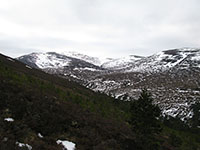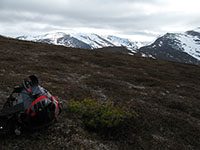A month ago I travelled to the Cairngorms for a high-level walk around the Allt a’ Mharcaidh catchment. The Allt a’ Mharcaidh is a relatively small river in the north-western Cairngorm mountains and is a tributary of the Spey, joining it at Kincraig via the river Feshie.
The catchment (or drainage basin, or watershed) of the Allt a’ Mharcaidh is relatively small (compared to other rivers in the Cairngorms like the Spey or the Dee) but is notable as it was chosen a couple of decades ago by the Macaulay Land Use Research Institute in Aberdeen as a sample upland mountain catchment for scientific study, and much hydrological research has been done into the soil and water chemistry of the catchment, and also the effects of precipitation and snowmelt on the hydrology of the catchment – see this page here for much detail about this.
The route of my walk started at the Lagganlia airstrip (used for gliders) and headed through the Scots Pines of the Inshriach Forest, past some rare examples of bog forest and up into the bowl of the Allt a’ Mharcaidh catchment.
On my walk I saw various instruments used in the scientific research carried out in the area, including measuring instruments in the Allt a’ Mharcaidh flow lower down in the catchment, as well as an automatic weather station higher up at an elevation of about 700m on the minor summit of Creag Follais, to the north of the catchment.
The slopes around Creag Follais have another environmental claim to fame, which is that they are host to one of the only examples of a natural tree line native to the British Isles, containing the highest altitude trees to be found anywhere in the British Isles.
Large Scots Pines can be found growing in the area to altitudes of about 600m, but on my walk around the Allt a’ Mharcaidh catchment I discovered that this tree line does not exist as a physical demarcation line at a definite altitude – as one gains in height from 600m to 700m, the Scots Pines gradually get less dense and smaller and smaller (these dwarf or semi-prostrate trees are called Krummholz trees in North America), but don’t disappear entirely until well above 600m. I found a dwarf Scots Pine growing on the shoulder of Clach Choutsaich at 790m which may well be the highest growing tree in Britain. Although it doesn’t look very impressive, it’s still a Scots Pine – see the photo to the right.
The route of my walk continued round the south of the catchment, to the high point of the summit of Sgòr Gaoith at an altitude of 1118m. There were still large areas covered with snow at this high altitude, with large cornices at the top of the cliffs on the eastern side of the ridge to the west of Glean Einich. There were great views from the summit to Braeriach and the flat expanse of the Mòine Mhòr, and also an encounter with a group of three Ptarmigan close to the summit. My walk continued around the catchment to Geal-charn via a snow-filled glacial meltwater channel and back to the starting point at Lagganlia.
You can see all the photos I took on this walk on my website here.


Eddie
A 1998 paper by Bayfield et al. contains details of studies carried out in the northen corries of the Cairngorms (a few kilometres to the east of the walk I did in this blog posting). These studies found Scots Pine trees up to an altitude of 850m, in line with the highest elevation tree I found on my walk around the Allt a’ Mharcaidh catchment.
In the paper, these small high-altitude trees are referred to as ‘saplings’ – it’s not clear to me what the difference is between this term and other terms used to describe these trees such as dwarf, prostrate, scrub, shrub and Krummholz.
(Bayfield N G, Fraser N M, Calle Z. 2008. High altitude colonisation of the Northern Corries of Cairn Gorm by Scots pine (Pinus sylvestris). Scottish Geographical Magazine 114. 172-179.)
Eddie
On a walk up Coire na Ciste in the northern corries of the Cairgorms, just east of the ski centre, I saw a dwarf Scots Pine on Creagan Dubh on the eastern slopes of Coire na Ciste at an altitude of 900m – higher than the one I saw on Clach Choutsaich and significantly higher than any mentioned in the 1998 Bayfield et al. paper.
Eddie
The phrase ‘tree line’ is not a particularly useful or accurate one in this context, given that the area in question is almost always a two-dimensional ‘band’, rather than a one-dimensional line. A more precise term used in the scientific literature is ‘ecotone‘, e.g. alpine treeline ecotone.
Eddie
On 12/12/12, Adam Watson posted this on the Winterhighland forum:
“I have seen Scots Pines on the Cairn Gorm-Ben Macdui plateau in several places, but they never survive long. I once saw one on the sandy ridge just on the plateau north-west of the Feith Buidhe waterfall. The highest one I have ever seen was in September 2003 on Ben Macdui on the flat bouldery ground west of the top of Garbh Uisge Beag, where the ground to the north slopes gently to a spring that feeds the March Burn, and to the south-west a lochan and springs that run into the northern part of Coire Mor. Botanist David Welch, soils scientist Rodney Heslop, Keith Duncan from SNH Aviemore and Ewan MacLeod a then ranger at Cairngorm ski area were with me and saw the small tree. I think it’s the highest record in the UK. ”
This would make the altitude of this tree about 1180m, almost certainly the highest ever observed growing tree in the British Isles.